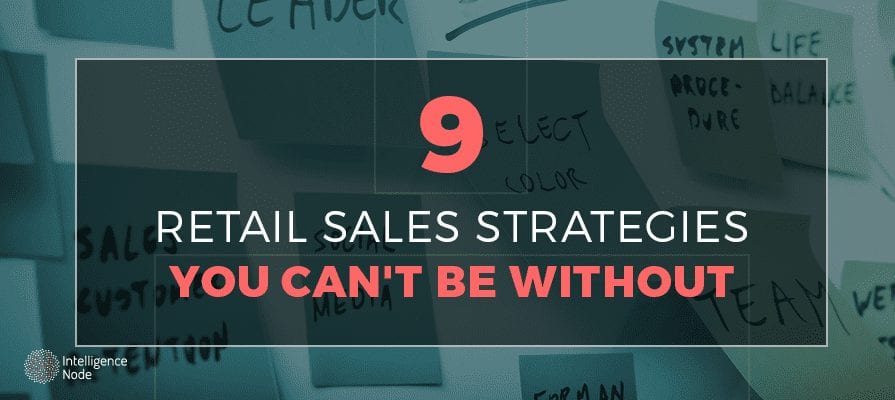Retail sales strategies can make or break your brand. Select the wrong approach and watch your business flounder as it wastes money on useless marketing ploys. The right strategy, by contrast, can yield success you never imagined, assisting even struggling businesses. So which retail sales strategies can infuse your business with new life and impressive profits? Try one of these eight winning tactics.
Create an Attractive Storefront — Real, Virtual, or Both
Imagine you’re out shopping. Do you go to the store with the cluttered or dull windows, or the shop with the beautiful displays, sleek sign, and ever-changing interior? Your storefront is the face you share with the world, so make sure it’s attractive.
This advice is doubly important for web-based businesses, which can’t compensate for unattractive storefronts with excellent in-person service and gorgeous products. Don’t forget the important virtual storefronts of social media and blogs. Your web presence, along with your storefront, must tell a compelling, attractive story. If you need to spend a little to beautify any part of your storefront, it will be money well-spent.
Offer Better Wages
If you make your cost calculations based solely on how much money you spend, you’ll come out a loser every time. Sometimes you have to spend money to make money, and nowhere is this truer than in your relationships with your employees.
How many times have you had a bad customer service interaction, only to permanently swear off a business? What do you think good employees do as soon as they get an offer of a higher wage? You know the answer to these questions, and that answer points toward the value of higher wages.
Your employees are the face you show the world. They’re brand ambassadors. Do you really want your ambassadors starting wars with, or neglecting, your customers? Dig deeper to afford long-term, committed employees. If you hire people who are efficient and effective, you may even be able to hire fewer people. This allows you to save money even in the face of higher wages.
Provide First-Rate Training
Even the best employees can’t do their jobs well if they don’t know what the job entails. Offer substantive training that helps committed employees correctly do their jobs. Forget empty team-building activities, mindless games, and vapid workbooks.
Your training sessions need to prepare your employees to deal with real-world situations such as:
- Fixing mistakes.
- Dealing with angry customers.
- Effective communication.
- Engaging customers without annoying them.
- Your brand’s values, goals, and public face.
- Recruiting new customers, and encouraging browsers to make a purchase.
Engage Your Customers
Most customers want to become loyal consumers. Give them something to love, and they’ll tell everyone about your business. One of the easiest ways to do this is to engage with your customers as human beings. No, this doesn’t mean mindlessly greeting a customer, forcing salespeople to follow scripts, or making endless small talk.
Engaging your customers is about treating them as human beings and starting a dialogue. Some technologies for accomplishing this include:
- Soliciting feedback on social media, or posting questions and responding to the answers. A social media community that is active and engaged is a valuable asset.
- Listening to what customers say — even when it’s something negative about your brand.
- Hiring friendly people with excellent social skills — not rude temporary workers, or drones who are only interested in following a script.
- Offering regular customer service training.
Create a Brand Culture
Successful brands have their own unique cultures. At Saddleback Leather, it’s a commitment to rugged, adventurous living and a zealous love of quality leather. At ModCloth, it’s fashion as personal expression, and a love of all things quirky. At Nintendo, it’s a willingness to make mistakes in the pursuit of progressively better and more lovable gadgets. What’s your brand’s culture?
If you can’t offer an immediate, appealing answer, something is wrong. Your staff won’t know how to behave if they don’t understand your culture. And consumers won’t know what to expect. Consider your corporate identity, and then use it to create a unique culture. Remember, customers love a brand with values, so consider how you can use your brand’s identity to give back to the community.
Make Your Customers Want Something They Can’t Have
It’s a tried-and-true retail sales strategy: offer products that consumers can’t have immediately, or that they must compete to get. This can be especially effective for new brands. Some options include:
- Making a new product available only through a platform such as Kickstarter, and only if you reach a funding goal.
- Advertising a new product well before it will be available.
- Offering only a limited run of a popular product.
Note that there is a fine line between creating desire and simply frustrating your customers. You must be able to deliver on your promises, and consumers must be able to get the products they want. The goal here is to encourage them to buy quickly and early, not to force them into stalking your brand.
Solicit Feedback
Soliciting honest feedback from your customers might seem scary, but it’s the only way to grow. Ask customers who have a positive experience to leave a review. Offer several ways for customers to leave private feedback, too. For example, try offering a discount to consumers who answer a survey. This feedback helps you understand your brand’s strengths and weaknesses, allowing you to seamlessly address unmet customer needs.
Know the Market
Every brand has competitors. To succeed, you must know yours. Shop competitors to get a feel for the experience, and ask new staff who previously worked for competitors how things were different. Conduct market research to learn what your competitors offer that you don’t, and why some customers choose your competitors over your business.
To succeed, you must offer something no one else does. That can be a price, a specific product, a customer service experience, or the cache of a much-coveted brand. But you can’t offer something no one else does if you don’t know what everyone else is offering. Ignore your competitors only at your peril.
[tac_ga url=”http://info.intelligencenode.com/key-automated-marketing-strategies-for-ecommerce-store-success” category=”Ebook Download” action=”Click” label=”Automated Marketing Strategies” target=”_blank”]





